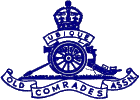 |
A Short History of the
|
prev index next |
|
With war clouds looming in Europe, and at a time when the Chief of the General Staff was endeavouring to build up the strength of the few Zealand Military Forces, the following resolution passed at an Executive meeting held in Wellington on 8 Dec 1938, is worth recalling: That as the youth of this country have failed to answer the call to arms, we the Executive unanimously offer the Section's services to the CGS when called upon to do so, to do our duty in any direction he may deem fit. When war was subsequently declared on 3 Sep 1939, many Old Comrades who were still fit rejoined the Forces, including not a few whose service had begun prior to the South African War. In the meantime the Auckland Section was in difficulties. The hostility of the Adjutant-General which resulted in the enforced resignations from its Executive of its two most active founding members, followed by the death of its President, Sir George Richardson, in 1938, were set-backs from which it had not recovered a year later. With the outbreak of war the Auckland Section simply 'faded away.' On the other hand Wellington, profiting from Auckland's experience, concentrated on attracting retired men, did not elect any serving soldiers to their Executive, and thus suffered no interference from Army Headquarters. The Section assumed national responsibilities throughout the war, at the end of which it became the Headquarters of the Association by mutual agreement, for by then it was receiving applications for membership from all over the country, including Auckland. In 1940 the Wellington Section took the lead in having a members' badge produced, calling for design suggestions from which one with a Gunner motif was selected. A miniature version of the RNZA cap badge became the basic structure, the wording 'NZ' and 'Old Comrades Assn' being substituted for 'Ubique' and 'Royal N.Z. Artillery' respectively. When stocks ran out the Association adopted a somewhat larger badge, changing the 'NZ' back to 'Ubique'. The price to members in those days was 2/6 (25c); today (1999) the same (larger) badge costs $4. It should be worn on the right lapel below the RSA badge, or as a tie pin. Although membership remained more or less static during the war years the Association was active and well supported. The President on one occasion congratulated the ex-Armed Constabulary men on the strong contingent they always turned out at the annual reunions. The writer well remembers those old grey-beards at the first reunion he attended in 1947; obviously to them it was the high-light of the year, they enjoyed every minute of it, as raconteurs they were without equal - and their capacity for beer few of the younger fry could beat! Having failed in an earlier attempt to obtain a grant from the Reward Fund through the Minister of Defence, the Executive approached the Minister of Internal Affairs, who not only gave them a sympathetic hearing but expressed a sincere interest in the Association's welfare work. He was instrumental in their receiving a number of grants from the current 'Art Unions', the forerunners of the modern Golden Kiwi lotteries. These additions to the Benevolent Fund were greatly appreciated. In 1938 the old age pension had been increased to 30/- ($3) a week, but it was still only 39% of the basic wage set in 1936, and thus could hardly be considered more than a subsistence allowance. With the cost of living steadily rising, and members growing older, rarely did an Executive meeting pass without cases of hardship being dealt with. Subversion of the war effort having occurred in certain quarters in Wellington, members of the Association undertook to report to the authorities any cases they might detect. Several were reported; in one case the President had occasion to highly commend a member who took appropriate action even though the culprits had threatened to take his life if he did so. Unfortunately further details are not available as in 1966 the Secretary was authorised to destroy all records over five years old. Subversive activities decreased when Russia entered the war on our side! See also the section of articles beginning with NZ Artillery of World War 2 previous | index | next | History index | Home | ||